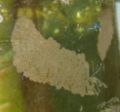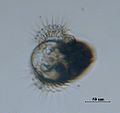Dolabrifera: Difference between revisions
Appearance
Content deleted Content added
GrahamBould (talk | contribs) Links |
GrahamBould (talk | contribs) ''Dolabrifera brazieri'' now separate page |
||
| Line 27: | Line 27: | ||
==Species within the genus ''Dolabrifera''== |
==Species within the genus ''Dolabrifera''== |
||
*''[[Dolabrifera brazieri]]'' <small>[[Sowerby (taxonomy)|Sowerby]], [[1870]]</small> |
*''[[Dolabrifera brazieri]]'' <small>[[Sowerby (taxonomy)|Sowerby]], [[1870]]</small> |
||
**Distribution : [[Australia]], [[New Zealand]]. |
|||
**Color : variable mimicking the background, but usually from pale yellow to mottled green |
|||
**Length : 15 [[centimetre|cm]] |
|||
**Description : mantle covered with conical [[tubercle]]s; fused [[parapodia]] (fleshy winglike flaps); found under rocks. |
|||
*''[[Dolabrifera dolabrifera]]'' <small>[[Georges Cuvier|Cuvier]], [[1817]]</small> |
*''[[Dolabrifera dolabrifera]]'' <small>[[Georges Cuvier|Cuvier]], [[1817]]</small> |
||
Revision as of 21:12, 23 January 2008
| Dolabrifera | |
|---|---|

| |
| Dolabrifera dolabrifera | |
Secure
| |
| Scientific classification | |
| Kingdom: | |
| Phylum: | |
| Class: | |
| Subclass: | |
| Superorder: | |
| Order: | |
| Suborder: | |
| Superfamily: | |
| Family: | |
| Genus: | Dolabrifera |
| Species | |
|
see text. | |
Dolabrifera (Gray, 1847) is a genus of sea hares, a taxonomic group of sea slugs or marine opisthobranch gastropod mollusks belonging to the family Aplysiidae.
A more general description can be found on the page of the superfamily Aplysioidea.
Species within the genus Dolabrifera
- Dolabrifera dolabrifera Cuvier, 1817
- Distribution : circumglobal; tropical and subtropical waters.
- Length : 4 cm
- Color : varies greatly between individuals and populations, mostly between beige and mottled green, but pink and chartreuse green has been spotted; this offers a good camouflage against the background.
- Description : rather flat mantle with a broad posterior, narrowing towards the head; fused parapodia, except for a short region in the posterior midline; eggs are zigzag-shaped ribbons, pink when laid then changing color to brown before hatching; moves in a unique way, like a leech; feeds mostly by grazing on filamentous algae.
- This species is frequently sold as "algae eating sea hare" at aquarium stores for saltwater and reef tanks.
Gallery
-
Dolabrifera dolabrifera egg ribbon 5 days old
-
Dolabrifera dolabrifera egg 7 days old, just before hatching



